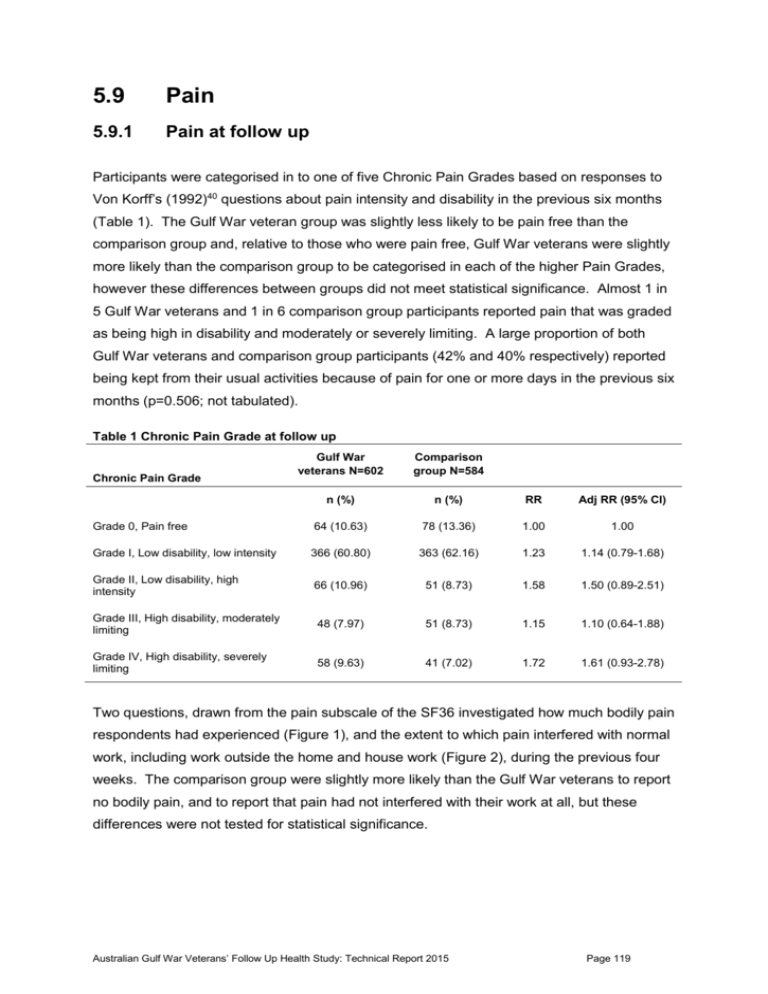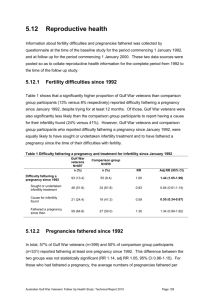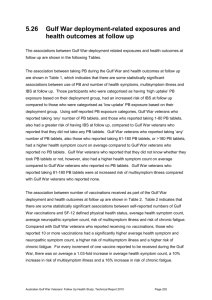Pain Pain at follow up
advertisement

5.9 Pain 5.9.1 Pain at follow up Participants were categorised in to one of five Chronic Pain Grades based on responses to Von Korff’s (1992)40 questions about pain intensity and disability in the previous six months (Table 1). The Gulf War veteran group was slightly less likely to be pain free than the comparison group and, relative to those who were pain free, Gulf War veterans were slightly more likely than the comparison group to be categorised in each of the higher Pain Grades, however these differences between groups did not meet statistical significance. Almost 1 in 5 Gulf War veterans and 1 in 6 comparison group participants reported pain that was graded as being high in disability and moderately or severely limiting. A large proportion of both Gulf War veterans and comparison group participants (42% and 40% respectively) reported being kept from their usual activities because of pain for one or more days in the previous six months (p=0.506; not tabulated). Table 1 Chronic Pain Grade at follow up Gulf War veterans N=602 Comparison group N=584 n (%) n (%) RR Adj RR (95% CI) Grade 0, Pain free 64 (10.63) 78 (13.36) 1.00 1.00 Grade I, Low disability, low intensity 366 (60.80) 363 (62.16) 1.23 1.14 (0.79-1.68) Grade II, Low disability, high intensity 66 (10.96) 51 (8.73) 1.58 1.50 (0.89-2.51) Grade III, High disability, moderately limiting 48 (7.97) 51 (8.73) 1.15 1.10 (0.64-1.88) Grade IV, High disability, severely limiting 58 (9.63) 41 (7.02) 1.72 1.61 (0.93-2.78) Chronic Pain Grade Two questions, drawn from the pain subscale of the SF36 investigated how much bodily pain respondents had experienced (Figure 1), and the extent to which pain interfered with normal work, including work outside the home and house work (Figure 2), during the previous four weeks. The comparison group were slightly more likely than the Gulf War veterans to report no bodily pain, and to report that pain had not interfered with their work at all, but these differences were not tested for statistical significance. Australian Gulf War Veterans’ Follow Up Health Study: Technical Report 2015 Page 119 35 Gulf War veterans 30 Comparison group Percentage (%) 25 20 15 10 5 0 None Very mild Mild Moderate Severe Very severe How much bodily pain have you had during the past 4 weeks? Figure 1 The severity of bodily pain in the four weeks prior to follow up 45 Gulf War veterans 40 Comparison group Percentage (%) 35 30 25 20 15 10 5 0 Not at all A little bit Moderately Quite a bit Extremely How much did pain interfere with normal work in the past 4 weeks? Figure 2 The extent to which pain interfered with normal work in the four weeks prior to follow up From a list of 19 body areas, the number of areas that participants reported having pain or tenderness in, over the previous 7 days, is shown in Table 2. Gulf War veterans were one and a half times more likely than comparison group participants to endorse between four and six body areas of pain, and more than two and half times more likely to endorse 11 or more body areas of pain. These differences between groups were statistically significant. Australian Gulf War Veterans’ Follow Up Health Study: Technical Report 2015 Page 120 Table 2 Number of body areas of pain or tenderness in the seven days prior to follow up Gulf War veterans N=693 Comparison group N=652 n (%) n (%) RR Adj RR (95% CI) 0-3 451 (65.08) 477 (73.16) 1.00 - 4-6 169 (24.39) 127 (19.48) 1.40 1.47 (1.12-1.93) 7-10 58 (8.37) 43 (6.60) 1.42 1.46 (0.95-2.26) 11+ 15 (2.16) 5 (0.77) 3.17 2.89 (1.01-8.28) Widespread Pain Number of body areas In the 63-item symptom questionnaire, for which results are presented in the Symptoms chapter, there were a number of pain-related symptoms which were reported statistically significantly more frequently by the Gulf War veterans relative to the comparison group. They include headaches (60% vs 49%, adj RR 1.19, 95% CI 1.08-1.31), pain without swelling or redness in several joints (46% vs 36%, adj RR=1.27, 95% CI 1.11-1.44), itchy or painful eyes (38% vs 29%, adj RR=1.27, 95% CI 1.09-1.48) and stomach cramps (19% vs 11%, adj RR=1.67, 95% CI 1.27-2.19). A number of additional pain-related symptoms were reported more frequently by Gulf War veterans however these differences just failed to achieve statistical significance; they were chest pain (21% vs 15%, adj RR 1.25, 95% CI 0.99-1.58) and general muscle aches or pains (63% vs 57%, adj RR 1.07, 95% CI 0.98-1.17). The most frequently reported pain-related health symptoms in both study groups were general muscle aches or pains, headaches and low back pain; each reported by more than half of all participants. 5.9.2 Key findings A large proportion of Gulf War veteran and comparison group participants have been adversely affected by pain in the 6 months prior to the follow up study. More than 40% of all participants reported being kept from their usual activities because of pain for one or more days in the six month period. For the same time period, almost 1 in 5 Gulf War veterans and 1 in 6 comparison group participants reported pain that was graded as being high in disability and moderately or severely limiting. Gulf War veterans were slightly less likely than comparison group participants to be pain free in the last six months, and slightly more likely to score a higher Chronic Pain Grade, however these differences between groups did not meet statistical significance. Australian Gulf War Veterans’ Follow Up Health Study: Technical Report 2015 Page 121 In the four week period prior to the follow up study, Gulf War veteran participants were, again, very slightly less likely to report no pain, and slightly more likely to report some interference with their normal work activities as a result of pain. From a list of 19 body areas, Gulf War veterans were one and a half times more likely than comparison group participants to report pain in four to six body areas in the previous seven days, and more than two and half times more likely to report 11 or more body areas of pain. These differences between groups, in number of body areas affected by pain, were statistically significant. Gulf War veterans were statistically significantly more likely than the comparison group to report a number of pain-related health symptoms in the past month; they included headaches, pain without swelling or redness in several joints, itchy or painful eyes and stomach cramps. The most frequently reported pain-related health symptoms in the past month, for both study groups, were general muscle aches or pains, headaches and low back pain; each reported by more than half of all participants. Australian Gulf War Veterans’ Follow Up Health Study: Technical Report 2015 Page 122










